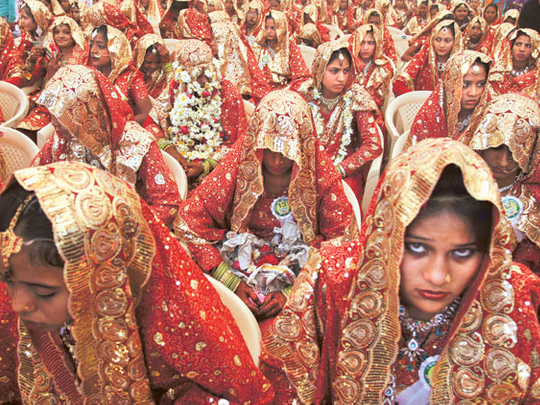
New Delhi: Marriage is one of the most holy and sacred ceremonies in the Indian society, but horror of the dowry system has made it look like one of the most feared institutions. The scourge of dowry is now emerging as the commonest criminal method of extortion which works with infliction of torture, violence, blackmail and many a time, murder of the bride.
The evil custom of dowry is spreading like wildfire in India with communities, which never traditionally practised dowry, now jumping on the bandwagon. The dowry system is thought to put great financial burden on the bride’s family which makes one of the reasons for families and women in India resorting to sex selection in favour of sons. Even after marriage, some brides are tortured and forced to bring more and more dowry from their parents’ house. If they fail, they are tortured and finally killed.
Some believe dowry was not a part of the Indian marriage before European influence crept into the society. The earliest example of Europeans practising the dowry in India was the case of Mumbai, which was presented as part of the dowry when Princess Catherine de Braganza of Portugal was married to King Charles II in 1661.
Historians believe the system of dowry existed in India even before the British Rule, but not in the format that is prevalent in the society today. In the pre-colonial period, dowry was an institution managed by women, for women, to enable them to establish their status and have recourse in an emergency. In this ancient system of dowry, the parents of the bride, even her kith and kin, all gave wealth to her in the form of valuable gifts etc. It was just like how parents used to give a part of wealth to their sons, so did they give it to their daughters too during the daughter’s marriage. The dowry wealth continued to be owned by the wife and not by the husband or his family.
But in spite of modernisation and the ever increasing role of women in all walks of life, the scourge of dowry in India is becoming widespread, and the value of dowries is increasing. When demands for dowry are not met, the bride is subject to torture, and often even killed. Many parents do not want to have daughters so as to escape the torture of dowry at the time their marriage. According to the National Crime Records Bureau, 8,233 women were killed across India last year because of disputes over dowry payments made by the family of bride to the family of groom at the time of marriage. The conviction rate in dowry-related crimes is a dismal 32 per cent.
Dowry killings have been described by some women’s rights groups as a problem that is typically among the urban middle class, who aspire to greater material prosperity, and the dowry that comes with a wife is viewed as a means of obtaining money and consumer goods. Dowry deaths are typically reported either as murder or suicide. Some reports of accidental deaths have later been prosecuted as dowry deaths. While dowry deaths are not the top 10 leading causes of all female deaths in India, they are sixth largest cause of crime-related violence against females in India.
In 2011, 8,391 dowry deaths were reported in India. With a total female population of about 587 million, dowry-related violence caused 1.4 deaths per year per 100,000 women in India, compared to 1,427 natural deaths per year per 100,000 women. Statistics in India show that 90 per cent of such murdered brides were educated, 30 per cent were graduates, and 20 per cent were women who worked outside the home and contributed to the family financially.
“Dowry originated in upper caste families as the wedding gift to the bride from her family. The dowry was later given to help with marriage expenses and became a form of insurance in the case that her in-laws mistreated her. Although the dowry was legally prohibited in 1961, it continues to be highly institutionalised. The reason many parents do not want to have daughters is because of the dowry they will have to shell out at her marriage, and the stress they go through due to never ending demands from her in-laws,” says women rights activist Meenakshi Nayar.
Payment of dowry is now prohibited under ‘the 1961 Dowry Prohibition Act’ in Indian civil law and subsequently by Sections 304B and 498a of the Indian Penal Code (IPC). Despite anti-dowry laws in India, it is still a common illegal practice. Other laws attempting to address the problem include ‘the Dowry and Bridal Gifts Restrictions Rules, 1976’ and ‘the Dowry Prohibition (Maintenance of Lists of Presents to the Bride and Bridegroom) Rules, 1985,’ which are intended to document gifts and provide complainants with stronger evidence in the event that prosecution for crimes against the bride occurs later.












